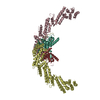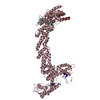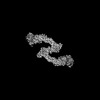+ データを開く
データを開く
- 基本情報
基本情報
| 登録情報 | データベース: PDB / ID: 8k9i | |||||||||||||||
|---|---|---|---|---|---|---|---|---|---|---|---|---|---|---|---|---|
| タイトル | Structure of CUL3-RBX1-KLHL22 complex without CUL3 NA motif | |||||||||||||||
 要素 要素 |
| |||||||||||||||
 キーワード キーワード | LIGASE / Cullin Ring E3 ubiquitin ligase | |||||||||||||||
| 機能・相同性 |  機能・相同性情報 機能・相同性情報positive regulation of mitotic cell cycle phase transition / trophectodermal cellular morphogenesis / liver morphogenesis / POZ domain binding / nuclear protein quality control by the ubiquitin-proteasome system / polar microtubule / regulation protein catabolic process at postsynapse / COPII vesicle coating / anaphase-promoting complex-dependent catabolic process / cullin-RING-type E3 NEDD8 transferase ...positive regulation of mitotic cell cycle phase transition / trophectodermal cellular morphogenesis / liver morphogenesis / POZ domain binding / nuclear protein quality control by the ubiquitin-proteasome system / polar microtubule / regulation protein catabolic process at postsynapse / COPII vesicle coating / anaphase-promoting complex-dependent catabolic process / cullin-RING-type E3 NEDD8 transferase / NEDD8 transferase activity / cellular response to L-leucine / RHOBTB3 ATPase cycle / cullin-RING ubiquitin ligase complex / positive regulation of T cell mediated immune response to tumor cell / positive regulation of mitotic metaphase/anaphase transition / cell projection organization / embryonic cleavage / cellular response to chemical stress / Cul7-RING ubiquitin ligase complex / ubiquitin-dependent protein catabolic process via the C-end degron rule pathway / Loss of Function of FBXW7 in Cancer and NOTCH1 Signaling / positive regulation of protein autoubiquitination / RNA polymerase II transcription initiation surveillance / protein neddylation / Notch binding / NEDD8 ligase activity / fibroblast apoptotic process / VCB complex / RHOBTB1 GTPase cycle / negative regulation of response to oxidative stress / Cul5-RING ubiquitin ligase complex / SCF ubiquitin ligase complex / Cul2-RING ubiquitin ligase complex / negative regulation of type I interferon production / ubiquitin-ubiquitin ligase activity / Cul4A-RING E3 ubiquitin ligase complex / SCF-dependent proteasomal ubiquitin-dependent protein catabolic process / stem cell division / Cul4-RING E3 ubiquitin ligase complex / Cul3-RING ubiquitin ligase complex / mitotic metaphase chromosome alignment / Cul4B-RING E3 ubiquitin ligase complex / ubiquitin ligase complex scaffold activity / mitotic spindle assembly checkpoint signaling / stress fiber assembly / negative regulation of mitophagy / negative regulation of Rho protein signal transduction / positive regulation of cytokinesis / Prolactin receptor signaling / cullin family protein binding / mitotic sister chromatid segregation / protein monoubiquitination / endoplasmic reticulum to Golgi vesicle-mediated transport / sperm flagellum / ubiquitin-like ligase-substrate adaptor activity / RHOBTB2 GTPase cycle / protein K48-linked ubiquitination / intercellular bridge / protein autoubiquitination / Nuclear events stimulated by ALK signaling in cancer / Regulation of BACH1 activity / gastrulation / positive regulation of protein ubiquitination / 14-3-3 protein binding / transcription-coupled nucleotide-excision repair / regulation of cellular response to insulin stimulus / positive regulation of TORC1 signaling / post-translational protein modification / negative regulation of autophagy / intrinsic apoptotic signaling pathway / negative regulation of insulin receptor signaling pathway / cyclin binding / T cell activation / Degradation of DVL / Recognition of DNA damage by PCNA-containing replication complex / Degradation of GLI1 by the proteasome / GSK3B and BTRC:CUL1-mediated-degradation of NFE2L2 / integrin-mediated signaling pathway / Negative regulation of NOTCH4 signaling / Vif-mediated degradation of APOBEC3G / Hedgehog 'on' state / Degradation of GLI2 by the proteasome / GLI3 is processed to GLI3R by the proteasome / DNA Damage Recognition in GG-NER / FBXL7 down-regulates AURKA during mitotic entry and in early mitosis / cellular response to amino acid stimulus / Degradation of beta-catenin by the destruction complex / Evasion by RSV of host interferon responses / kidney development / Oxygen-dependent proline hydroxylation of Hypoxia-inducible Factor Alpha / NOTCH1 Intracellular Domain Regulates Transcription / Dual Incision in GG-NER / Transcription-Coupled Nucleotide Excision Repair (TC-NER) / Formation of TC-NER Pre-Incision Complex / Constitutive Signaling by NOTCH1 PEST Domain Mutants / Constitutive Signaling by NOTCH1 HD+PEST Domain Mutants / G1/S transition of mitotic cell cycle / negative regulation of canonical Wnt signaling pathway / Formation of Incision Complex in GG-NER 類似検索 - 分子機能 | |||||||||||||||
| 生物種 |  Homo sapiens (ヒト) Homo sapiens (ヒト) | |||||||||||||||
| 手法 | 電子顕微鏡法 / 単粒子再構成法 / クライオ電子顕微鏡法 / 解像度: 4.2 Å | |||||||||||||||
 データ登録者 データ登録者 | Wang, W. / Ling, L. / Dai, Z. / Zuo, P. / Yin, Y. | |||||||||||||||
| 資金援助 |  中国, 4件 中国, 4件
| |||||||||||||||
 引用 引用 |  ジャーナル: Nat Commun / 年: 2024 ジャーナル: Nat Commun / 年: 2024タイトル: A conserved N-terminal motif of CUL3 contributes to assembly and E3 ligase activity of CRL3. 著者: Weize Wang / Ling Liang / Zonglin Dai / Peng Zuo / Shang Yu / Yishuo Lu / Dian Ding / Hongyi Chen / Hui Shan / Yan Jin / Youdong Mao / Yuxin Yin /  要旨: The CUL3-RING E3 ubiquitin ligases (CRL3s) play an essential role in response to extracellular nutrition and stress stimuli. The ubiquitin ligase function of CRL3s is activated through dimerization. ...The CUL3-RING E3 ubiquitin ligases (CRL3s) play an essential role in response to extracellular nutrition and stress stimuli. The ubiquitin ligase function of CRL3s is activated through dimerization. However, how and why such a dimeric assembly is required for its ligase activity remains elusive. Here, we report the cryo-EM structure of the dimeric CRL3 complex and reveal a conserved N-terminal motif in CUL3 that contributes to the dimerization assembly and the E3 ligase activity of CRL3. We show that deletion of the CUL3 N-terminal motif impairs dimeric assembly and the E3 ligase activity of both CRL3 and several other CRL3s. In addition, we found that the dynamics of dimeric assembly of CRL3 generates a variable ubiquitination zone, potentially facilitating substrate recognition and ubiquitination. These findings demonstrate that a CUL3 N-terminal motif participates in the assembly process and provide insights into the assembly and activation of CRL3s. | |||||||||||||||
| 履歴 |
|
- 構造の表示
構造の表示
| 構造ビューア | 分子:  Molmil Molmil Jmol/JSmol Jmol/JSmol |
|---|
- ダウンロードとリンク
ダウンロードとリンク
- ダウンロード
ダウンロード
| PDBx/mmCIF形式 |  8k9i.cif.gz 8k9i.cif.gz | 183.5 KB | 表示 |  PDBx/mmCIF形式 PDBx/mmCIF形式 |
|---|---|---|---|---|
| PDB形式 |  pdb8k9i.ent.gz pdb8k9i.ent.gz | 141.6 KB | 表示 |  PDB形式 PDB形式 |
| PDBx/mmJSON形式 |  8k9i.json.gz 8k9i.json.gz | ツリー表示 |  PDBx/mmJSON形式 PDBx/mmJSON形式 | |
| その他 |  その他のダウンロード その他のダウンロード |
-検証レポート
| 文書・要旨 |  8k9i_validation.pdf.gz 8k9i_validation.pdf.gz | 1.3 MB | 表示 |  wwPDB検証レポート wwPDB検証レポート |
|---|---|---|---|---|
| 文書・詳細版 |  8k9i_full_validation.pdf.gz 8k9i_full_validation.pdf.gz | 1.3 MB | 表示 | |
| XML形式データ |  8k9i_validation.xml.gz 8k9i_validation.xml.gz | 53 KB | 表示 | |
| CIF形式データ |  8k9i_validation.cif.gz 8k9i_validation.cif.gz | 75.4 KB | 表示 | |
| アーカイブディレクトリ |  https://data.pdbj.org/pub/pdb/validation_reports/k9/8k9i https://data.pdbj.org/pub/pdb/validation_reports/k9/8k9i ftp://data.pdbj.org/pub/pdb/validation_reports/k9/8k9i ftp://data.pdbj.org/pub/pdb/validation_reports/k9/8k9i | HTTPS FTP |
-関連構造データ
| 関連構造データ |  36987MC  8k8tC M: このデータのモデリングに利用したマップデータ C: 同じ文献を引用 ( |
|---|---|
| 類似構造データ | 類似検索 - 機能・相同性  F&H 検索 F&H 検索 |
- リンク
リンク
- 集合体
集合体
| 登録構造単位 | 
|
|---|---|
| 1 |
|
- 要素
要素
| #1: タンパク質 | 分子量: 87432.312 Da / 分子数: 1 / 由来タイプ: 組換発現 / 由来: (組換発現)  Homo sapiens (ヒト) / 遺伝子: CUL3 Homo sapiens (ヒト) / 遺伝子: CUL3発現宿主:  参照: UniProt: Q13618 | ||
|---|---|---|---|
| #2: タンパク質 | 分子量: 20365.340 Da / 分子数: 2 / 由来タイプ: 組換発現 / 由来: (組換発現)  Homo sapiens (ヒト) / 遺伝子: KLHL22 Homo sapiens (ヒト) / 遺伝子: KLHL22発現宿主:  参照: UniProt: Q53GT1 #3: タンパク質 | | 分子量: 12289.977 Da / 分子数: 1 / 由来タイプ: 組換発現 / 由来: (組換発現)  Homo sapiens (ヒト) / 遺伝子: RBX1, RNF75, ROC1 Homo sapiens (ヒト) / 遺伝子: RBX1, RNF75, ROC1発現宿主:  参照: UniProt: P62877 |
-実験情報
-実験
| 実験 | 手法: 電子顕微鏡法 |
|---|---|
| EM実験 | 試料の集合状態: PARTICLE / 3次元再構成法: 単粒子再構成法 |
- 試料調製
試料調製
| 構成要素 | 名称: CUL3-RBX1-KLHL22 complex without CUL3 NA motif / タイプ: COMPLEX / Entity ID: all / 由来: RECOMBINANT | ||||||||||||||||||||
|---|---|---|---|---|---|---|---|---|---|---|---|---|---|---|---|---|---|---|---|---|---|
| 由来(天然) | 生物種:  Homo sapiens (ヒト) Homo sapiens (ヒト) | ||||||||||||||||||||
| 由来(組換発現) | 生物種:  | ||||||||||||||||||||
| 緩衝液 | pH: 7.5 | ||||||||||||||||||||
| 緩衝液成分 |
| ||||||||||||||||||||
| 試料 | 濃度: 2 mg/ml / 包埋: NO / シャドウイング: NO / 染色: NO / 凍結: YES | ||||||||||||||||||||
| 試料支持 | グリッドのタイプ: Quantifoil R1.2/1.3 | ||||||||||||||||||||
| 急速凍結 | 装置: FEI VITROBOT MARK IV / 凍結剤: ETHANE / 湿度: 100 % / 凍結前の試料温度: 277 K |
- 電子顕微鏡撮影
電子顕微鏡撮影
| 実験機器 |  モデル: Titan Krios / 画像提供: FEI Company |
|---|---|
| 顕微鏡 | モデル: FEI TITAN KRIOS |
| 電子銃 | 電子線源:  FIELD EMISSION GUN / 加速電圧: 300 kV / 照射モード: FLOOD BEAM FIELD EMISSION GUN / 加速電圧: 300 kV / 照射モード: FLOOD BEAM |
| 電子レンズ | モード: DIFFRACTION / 最大 デフォーカス(公称値): 2000 nm / 最小 デフォーカス(公称値): 1500 nm |
| 撮影 | 電子線照射量: 50 e/Å2 / 検出モード: SUPER-RESOLUTION フィルム・検出器のモデル: GATAN K2 SUMMIT (4k x 4k) |
- 解析
解析
| EMソフトウェア |
| ||||||||||||||||||||||||
|---|---|---|---|---|---|---|---|---|---|---|---|---|---|---|---|---|---|---|---|---|---|---|---|---|---|
| CTF補正 | タイプ: PHASE FLIPPING AND AMPLITUDE CORRECTION | ||||||||||||||||||||||||
| 粒子像の選択 | 選択した粒子像数: 74279 | ||||||||||||||||||||||||
| 3次元再構成 | 解像度: 4.2 Å / 解像度の算出法: FSC 0.143 CUT-OFF / 粒子像の数: 74279 / 対称性のタイプ: POINT |
 ムービー
ムービー コントローラー
コントローラー







 PDBj
PDBj








